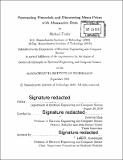| dc.contributor.advisor | Devavrat Shah. | en_US |
| dc.contributor.author | Fleder, Michael(Michael S.) | en_US |
| dc.contributor.other | Massachusetts Institute of Technology. Department of Electrical Engineering and Computer Science. | en_US |
| dc.date.accessioned | 2020-03-09T18:51:39Z | |
| dc.date.available | 2020-03-09T18:51:39Z | |
| dc.date.copyright | 2019 | en_US |
| dc.date.issued | 2019 | en_US |
| dc.identifier.uri | https://hdl.handle.net/1721.1/124061 | |
| dc.description | Thesis: Ph. D., Massachusetts Institute of Technology, Department of Electrical Engineering and Computer Science, 2019 | en_US |
| dc.description | Cataloged from PDF version of thesis. | en_US |
| dc.description | Includes bibliographical references (pages 101-105). | en_US |
| dc.description.abstract | In the financial industry, key quantities like public-company financials and consumer spending drive asset pricing and other decisions. However, direct observation of any company's financials or other key signals is rare. For instance, although public companies disclose their financials through quarterly reports and press releases, disclosures are infrequent and of limited information. This has led to an explosion in demand for "alternative" datasets: noisy, secondary signals of fine-grained company financials. Alternative datasets -- e.g. consumer credit card transactions -- | en_US |
| dc.description.abstract | are increasingly available; however, quantitative methods for utilizing such noisy proxy signals are lacking. In this work, we develop quantitative methods for utilizing alternative data. Starting with datasets of anonymized consumer transactions, we focus on two problems: (i) forecasting and tracking company financials and (ii) estimating the prices customers pay for individual goods, and in what quantity. That is, first we estimate aggregate company financials (e.g. quarterly revenue) before zooming in to study customer spending details. Utilizing a novel forecasting and estimation framework, we outperform a standard Wall Street consensus benchmark in forecasting the quarterly financials of 34 public companies. Next, we perform seemingly counterintuitive inference: given an anonymous consumer's bill total (a single number), we estimate the number and prices of products purchased. | en_US |
| dc.description.abstract | We show implications in (i) detecting changes in product offerings and (ii) performing revenue attribution by product. To forecast and track company financials, we utilize a classical linear systems model to capture both the evolution of the hidden or latent state (e.g. daily revenue), as well as the proxy signal (e.g. credit cards transactions). We analytically solve the often irresolvable system identification problem, and provide a finite-sample analysis of the resulting error. We show this enables optimal inference with respect to mean-squared error. Last, we provide a novel, robust estimation algorithm for decomposing bill totals into the underlying, individual product(s) purchases. We prove correctness and accuracy under mild assumptions. | en_US |
| dc.description.statementofresponsibility | by Michael Fleder. | en_US |
| dc.format.extent | 105 pages | en_US |
| dc.language.iso | eng | en_US |
| dc.publisher | Massachusetts Institute of Technology | en_US |
| dc.rights | MIT theses are protected by copyright. They may be viewed, downloaded, or printed from this source but further reproduction or distribution in any format is prohibited without written permission. | en_US |
| dc.rights.uri | http://dspace.mit.edu/handle/1721.1/7582 | en_US |
| dc.subject | Electrical Engineering and Computer Science. | en_US |
| dc.title | Forecasting financials and discovering menu prices with alternative data | en_US |
| dc.type | Thesis | en_US |
| dc.description.degree | Ph. D. | en_US |
| dc.contributor.department | Massachusetts Institute of Technology. Department of Electrical Engineering and Computer Science | en_US |
| dc.identifier.oclc | 1142101357 | en_US |
| dc.description.collection | Ph.D. Massachusetts Institute of Technology, Department of Electrical Engineering and Computer Science | en_US |
| dspace.imported | 2020-03-09T18:51:37Z | en_US |
| mit.thesis.degree | Doctoral | en_US |
| mit.thesis.department | EECS | en_US |
